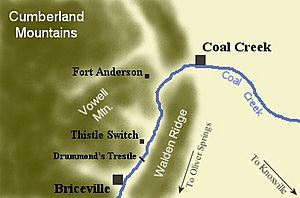Coal Creek War facts for kids
Quick facts for kids Coal Creek War |
|||
|---|---|---|---|
| Part of the Coal Wars | |||

Key locations during the Coal Creek War
|
|||
| Date | April 1891 – August 1892 | ||
| Location | |||
| Goals | End convict leasing by coal companies | ||
| Resulted in | State ending convict leasing in 1896 | ||
| Parties to the civil conflict | |||
|
|||
| Lead figures | |||
|
|||
| Casualties | |||
|
|||
The Coal Creek War was an early 1890s armed labor uprising in the southeastern United States that took place primarily in Anderson County, Tennessee. This labor conflict ignited during 1891 when coal mine owners in the Coal Creek watershed began to remove and replace their company-employed, private coal miners then on the payroll with convict laborers leased out by the Tennessee state prison system.
These former wage-earning Coal Creek coal miners repeatedly attacked and burned both state prison stockades and mine properties, all while releasing hundreds of the state convict laborers from their bondage to the mine companies. Many of these same Coal Creek coal miners were also wounded or killed in small-arms skirmishes during the Coal Creek War, along with dozens of Tennessee state militiamen.
One historian describes the Coal Creek War as "one of the most dramatic and significant episodes in all American labor history."
The Coal Creek War was itself part of a greater labor struggle across Tennessee that was launched against the state government's controversial convict-leasing system, which allowed the state prison system to lease convict labor to mining companies (and other business enterprises) with the effect of suppressing employee wages in the open market across the state. The outbreak of this labor conflict touched off a partisan media firestorm between the miners' supporters and detractors and brought the issue of convict leasing to the public debate.
Although the Coal Creek War essentially ended with the arrests of hundreds of former company coal miners during 1892, the adverse exposure that this state conflict with private labor generated nationwide led to the downfall of Governor John P. Buchanan, and forced the Tennessee General Assembly to reconsider its state convict labor-leasing system. The Tennessee state government later refused to renew its convict labor-lease contracts with private businesses upon the arrival at the 1896 expiration dates, making Tennessee one of the first states within the southern United States to end this controversial practice.
Legacy
The Coal Creek Watershed Foundation presently works to preserve the legacy of the Coal Creek War and its impact on the area and has taken the initiative in locating the remains of Fort Anderson and several poorly-marked or unmarked convict graves near the old Knoxville Iron Company mine. Much of the land purchased by the state in 1896 for the construction of Brushy Mountain State Penitentiary is now part of Frozen Head State Park.
The Coal Creek War provided inspiration for some of the earliest Appalachian coal mining protest music. Songs about the conflict include "Coal Creek Troubles," written in the wake of the conflict and recorded by Jilson Setters in 1937, and a banjo tune called "Coal Creek March," which was recorded by Kentucky banjoist Pete Seeger for the Library of Congress in 1938 and is still popular among bluegrass musicians. The song "Buddy Won't You Roll Down the Line", written and performed by Grand Ole Opry pioneer Uncle Dave Macon, was based on the Coal Creek War.

